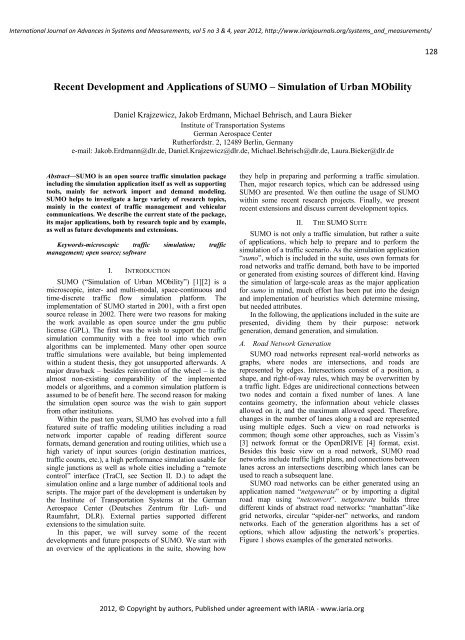c - IARIA Journals
c - IARIA Journals
c - IARIA Journals
Create successful ePaper yourself
Turn your PDF publications into a flip-book with our unique Google optimized e-Paper software.
International Journal on Advances in Systems and Measurements, vol 5 no 3 & 4, year 2012, http://www.iariajournals.org/systems_and_measurements/<br />
Recent Development and Applications of SUMO – Simulation of Urban MObility<br />
Daniel Krajzewicz, Jakob Erdmann, Michael Behrisch, and Laura Bieker<br />
Institute of Transportation Systems<br />
German Aerospace Center<br />
Rutherfordstr. 2, 12489 Berlin, Germany<br />
e-mail: Jakob.Erdmann@dlr.de, Daniel.Krajzewicz@dlr.de, Michael.Behrisch@dlr.de, Laura.Bieker@dlr.de<br />
Abstract—SUMO is an open source traffic simulation package<br />
including the simulation application itself as well as supporting<br />
tools, mainly for network import and demand modeling.<br />
SUMO helps to investigate a large variety of research topics,<br />
mainly in the context of traffic management and vehicular<br />
communications. We describe the current state of the package,<br />
its major applications, both by research topic and by example,<br />
as well as future developments and extensions.<br />
Keywords-microscopic traffic simulation; traffic<br />
management; open source; software<br />
I. INTRODUCTION<br />
SUMO (“Simulation of Urban MObility”) [1][2] is a<br />
microscopic, inter- and multi-modal, space-continuous and<br />
time-discrete traffic flow simulation platform. The<br />
implementation of SUMO started in 2001, with a first open<br />
source release in 2002. There were two reasons for making<br />
the work available as open source under the gnu public<br />
license (GPL). The first was the wish to support the traffic<br />
simulation community with a free tool into which own<br />
algorithms can be implemented. Many other open source<br />
traffic simulations were available, but being implemented<br />
within a student thesis, they got unsupported afterwards. A<br />
major drawback – besides reinvention of the wheel – is the<br />
almost non-existing comparability of the implemented<br />
models or algorithms, and a common simulation platform is<br />
assumed to be of benefit here. The second reason for making<br />
the simulation open source was the wish to gain support<br />
from other institutions.<br />
Within the past ten years, SUMO has evolved into a full<br />
featured suite of traffic modeling utilities including a road<br />
network importer capable of reading different source<br />
formats, demand generation and routing utilities, which use a<br />
high variety of input sources (origin destination matrices,<br />
traffic counts, etc.), a high performance simulation usable for<br />
single junctions as well as whole cities including a “remote<br />
control” interface (TraCI, see Section II. D.) to adapt the<br />
simulation online and a large number of additional tools and<br />
scripts. The major part of the development is undertaken by<br />
the Institute of Transportation Systems at the German<br />
Aerospace Center (Deutsches Zentrum für Luft- und<br />
Raumfahrt, DLR). External parties supported different<br />
extensions to the simulation suite.<br />
In this paper, we will survey some of the recent<br />
developments and future prospects of SUMO. We start with<br />
an overview of the applications in the suite, showing how<br />
they help in preparing and performing a traffic simulation.<br />
Then, major research topics, which can be addressed using<br />
SUMO are presented. We then outline the usage of SUMO<br />
within some recent research projects. Finally, we present<br />
recent extensions and discuss current development topics.<br />
II. THE SUMO SUITE<br />
SUMO is not only a traffic simulation, but rather a suite<br />
of applications, which help to prepare and to perform the<br />
simulation of a traffic scenario. As the simulation application<br />
“sumo”, which is included in the suite, uses own formats for<br />
road networks and traffic demand, both have to be imported<br />
or generated from existing sources of different kind. Having<br />
the simulation of large-scale areas as the major application<br />
for sumo in mind, much effort has been put into the design<br />
and implementation of heuristics which determine missing,<br />
but needed attributes.<br />
In the following, the applications included in the suite are<br />
presented, dividing them by their purpose: network<br />
generation, demand generation, and simulation.<br />
A. Road Network Generation<br />
SUMO road networks represent real-world networks as<br />
graphs, where nodes are intersections, and roads are<br />
represented by edges. Intersections consist of a position, a<br />
shape, and right-of-way rules, which may be overwritten by<br />
a traffic light. Edges are unidirectional connections between<br />
two nodes and contain a fixed number of lanes. A lane<br />
contains geometry, the information about vehicle classes<br />
allowed on it, and the maximum allowed speed. Therefore,<br />
changes in the number of lanes along a road are represented<br />
using multiple edges. Such a view on road networks is<br />
common; though some other approaches, such as Vissim’s<br />
[3] network format or the OpenDRIVE [4] format, exist.<br />
Besides this basic view on a road network, SUMO road<br />
networks include traffic light plans, and connections between<br />
lanes across an intersections describing which lanes can be<br />
used to reach a subsequent lane.<br />
SUMO road networks can be either generated using an<br />
application named “netgenerate” or by importing a digital<br />
road map using “netconvert”. netgenerate builds three<br />
different kinds of abstract road networks: “manhattan”-like<br />
grid networks, circular “spider-net” networks, and random<br />
networks. Each of the generation algorithms has a set of<br />
options, which allow adjusting the network’s properties.<br />
Figure 1 shows examples of the generated networks.<br />
2012, © Copyright by authors, Published under agreement with <strong>IARIA</strong> - www.iaria.org<br />
128







